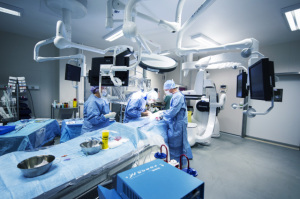by
Carol Ko, Staff Writer | April 17, 2013

GE Healthcare’s Discovery IGS 730 in-situ
(courtesy of GE Healthcare and
the University Of Lille, France)
From the April 2013 issue of HealthCare Business News magazine
One of the challenges hospitals face when buying imaging systems is making sure their equipment can adapt to new twists and developments within the industry for the next decade.
This is especially true when it comes to cath angio systems. Advances in cardiology have made the cath lab an increasingly complex space. To help hospitals anticipate major trends that will shape cath labs of the future, DOTmed Business News spoke with industry experts and cardiologists to get their predictions about where cath labs are going next.
New kids in town



Ad Statistics
Times Displayed: 16418
Times Visited: 33 Final days to save an extra 10% on Imaging, Ultrasound, and Biomed parts web prices.* Unlimited use now through September 30 with code AANIV10 (*certain restrictions apply)
Hybrid procedures like TAVI have already made a huge impact on cath labs, driving the growth of the hybrid OR. But this heart procedure, approved for limited use in the U.S. since late 2011, isn’t an anomaly by any means. Manufacturers are pushing the envelope by developing a whole class of new devices intended for patients who are either ineligible or unresponsive to conventional treatments.
Take hypertension for example. A new balloon catheter device called Vessix sends ablative shocks through tiny electrodes to the renal artery, communicating signals to the brain that tell it to lower blood pressure. Dr. Shing-Chui Wong, director of cardiac catheterization at Perelman Heart Institute at New York-Presbyterian Hospital/Weill Cornell Medical Center, predicts this will be a major tool for treating drug-resistant patients. “It will likely come on the scene and become a mainstay of therapy in three, four, five years from now,” he says.
Another such device is Watchman, a tiny umbrellashaped device designed to catch blood clots in patients at high risk for stroke. The device, developed by Boston Scientific, is intended to be an alternative to blood-thinning medication. It has already gone through multiple long-term trials and Boston Scientific is expected to submit these results for FDA approval soon.
These procedures, which are minimally invasive and require shorter recovery times, coupled with the pressures hospitals are experiencing due to reimbursement cuts, are going to push cath labs toward same-day outpatient procedures.
“We see a growth in what we would call office-spaced or outpatient imaging, and that’s being driven by improvements in devices that can be safely and effectively implanted in a nonhospital setting,” says Greg McIff, global director of cardiovascular strategic marketing, GE Healthcare Surgery.
Echo Chamber
But as the procedures grow increasingly complex, they require more complex imaging tools. “We’re in a particularly exciting era right now when we see the ability to migrate some of these more invasive procedures to image-guided approaches,” says Robert Dewey, senior director of product marketing, cardiology and hybrid OR at Siemens.

